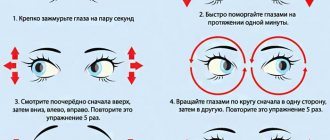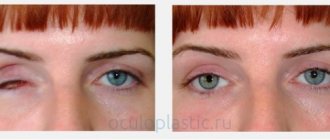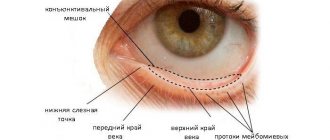Myopia and farsightedness develop for different reasons. In most cases, these diseases are inherited. Sometimes they occur as a result of injuries and eye diseases. Psychosomatics, a branch of medicine that studies the psychological factors that provoke physical ailments, is also looking for the causes of visual impairment.
In this article
- The connection between psychosomatics and vision
- Psychological causes of myopia in children
- Psychological causes of myopia in adults
- How to cope with the psychosomatics of myopia?
- Farsightedness and psychosomatics
- How are the psychological causes of farsightedness eliminated?
- What other eye diseases are associated with psychosomatics?
- What do psychologists advise to do to avoid eye diseases?
The connection between psychosomatics and vision
Scientists have come to the conclusion that the causes of any physical illness can be physiological factors, that is, a person’s mental state. This statement is not pseudoscientific, and psychologists have many facts and evidence in their arsenal. Today, psychologists have sufficient objective data that allows them to connect a person’s emotional or mental state with certain physiological diseases. In other words, psychosomatics can be hidden behind a variety of bodily ailments, including vegetative-vascular dystonia, ulcers, and ophthalmopathologies.
As for visual pathologies, in general they are caused by reasons that can be conditionally grouped into three groups:
- Genetic predisposition.
- Eye diseases and injuries.
- A lot of strain on the eyes in the absence of proper organization of working time and space, eye exercises and vitamins for the visual organs.
These reasons are called by official medicine. If we are talking about psychosomatics, that is, psychological reasons, then the deterioration of visual functions is associated with a person’s reluctance to notice anything in the world around him. He refuses to see certain things because they cause him mental discomfort.
At first glance, such ideas seem too speculative, groundless and unsubstantiated. However, certain patterns that emerge during the study of connections between visual impairment and a person’s internal state indicate the opposite.
Let’s take a closer look at what psychological causes of myopia and farsightedness exist, and also learn the psychosomatics of other eye diseases.
Psychological causes of myopia in children
First, let's briefly define myopia. Myopia is a vision defect caused by damage to one or more structures of the refractive system of the eye and a violation of the refractive ability of the eyeball. With this disease, a person sees well what is nearby and poorly distinguishes distant objects. With a weak degree of refractive error, the patient sees without problems at arm's length. In severe forms of myopia, it is difficult for a person to distinguish even what is at a distance of 23-30 cm from the face.
In most cases, myopia develops in childhood and can be triggered by a variety of factors. If we abstract from official medical data and move on to psychosomatics, the following psychological causes of myopia are identified.
The reasons for myopia in children can be strict upbringing and conflict situations that arise in the family. According to psychologists, a child is not capable of independently coping with the stress that develops against the backdrop of scandals in the family. He may not even be aware of it. However, the body helps it protect itself from an unfavorable external environment. Myopia becomes this protective reaction of the body. So the child tries not to see what is happening around him.
At the same time, psychosomatics is a rather complex phenomenon. How the same factor can affect different people is quite difficult to predict. Thus, a child who lives in a prosperous family and is surrounded by love and care may experience stress when he first attends kindergarten or school. At home he always felt safe and comfortable. The new environment may make him afraid. Educators may turn out to be much stricter than parents, and other situations and reasons are possible. Against this background, myopia can reappear. It becomes a way for the body to escape from the hostile world, an opportunity to simply not notice it.
Child psyche
If a child has poor vision, then you should immediately seek help from a specialized specialist at a medical institution. An ophthalmologist will diagnose and prescribe adequate treatment. Fortunately, if you start treatment in a timely manner, you can completely restore eye function and prevent dangerous complications. If we talk about the psychosomatic sources of the pathological condition, we can note:
- stress under increased workload;
- conflict situations at school and at home;
- excessive demands from parents.
It is important to understand that emotional pressure can provoke various changes in the functioning of the body. That is why the complex of therapy always includes normalization of the psyche (consultations with a specialist, quality rest).
Psychological causes of myopia in adults
Myopia often develops in adulthood. The reasons for the development of myopia are injuries, eye diseases, and constant work at the computer. Psychologists, including V. Sinelnikov, Louise Hay and Lise Burbo, also identify psychological factors that provoke myopia. They are also associated with emotions, the main one being fear. Graduates who need to decide on a choice of profession or place of work experience excitement before adulthood. Fear and anxiety can lead to the same reaction in the body as described above in relation to children.
In addition, scientists have found the following patterns. Myopic people are more focused on themselves and tend to criticize other people. Also, a person suffering from myopia usually does not like to make forecasts for the future or make plans for the year ahead, but is more focused on pressing problems, his family and himself. Many nearsighted people tend to idealize themselves. Ophthalmologists sometimes take these factors into account when prescribing treatment.
What can be done
First of all, you should change your lifestyle. In any case, you will have to give up bad habits (especially alcohol abuse) and normalize your diet. It is important that the body receives all the necessary beneficial microelements. Vitamin complexes and sedative tablets are often prescribed. We must not forget about normal sleep. A good night's rest is the key to emotional balance.
Doctors' recommendations:
- active sports help relieve the brain;
- choosing a relaxing hobby is calming;
- self-control and auto-training strengthen nerves.
Periodic consultations with a psychologist will not be superfluous. Sometimes ordinary communication and release of negative emotions are enough.
How to cope with the psychosomatics of myopia?
The most effective method of treating myopia is laser vision correction. However, it has contraindications due to health and age. In this case, correction means are prescribed - contact lenses or glasses. Also, to stop the progression of myopia, hardware therapy, eye gymnastics, and vitamin complexes are prescribed. If the cause of myopia is psychosomatics, it must also be eliminated.
For this it is recommended:
- visit a psychologist;
- read specialized literature related to the psychological causes of visual impairment;
- normalize the daily routine;
- go in for sports, dance or other interesting and distracting activities from life's problems.
During sessions with a psychologist, the doctor tries to find out the main fear that became the catalyst for myopia. The patient may not be aware of this fear. The psychologist’s task is to reveal it and learn to deal with it. Such sessions do not exempt you from regular treatment. It is impossible to cure a physical illness by eliminating only its supposed psychological problems. But, as with any disease, an integrated approach to solving the problem gives the most effective results. In this case, an integrated approach consists of the joint work of an ophthalmologist and a psychologist, as well as the desire of the patient himself to interact with both doctors. This is especially important in childhood, when eye surgery is not prescribed.
Psychosomatics of vision loss. Introductory session
So, the cleansing session took place, which I was really looking forward to. I myself have carried out cleansing more than once, only this happened through the VY. And the request was to cleanse the channels and meridians, the energy structure. Accordingly, I saw only the work of energy in my structure. This session is built on a completely different principle.
I found myself in a space where the Soul sometimes leads me. It’s very comfortable for her there, it’s her favorite place. It is not on the physical plane, I have never been in such mountains, with such transparent air, as pure as a tear. There are ledges of high mountains with snow caps around. The sun is bright, but it feels comfortably cool. There is a large bird on a nearby ledge; it also appears in my sessions. This is not VYa and not the Guardian. I feel her as a messenger from the Mentors. She's watching to make sure I'm okay (protection)
I feel calm and comfortable here. VYa appears as a man in white loose robes. I used to take him for a teacher who takes lessons with me in this space.
We begin cleaning the eyes... there is a cloudy, veil, viscous state inside. “Oblivion” sounds... And I am thrown into one of my past incarnations.
I'm above the city. Lots of gilded roofs and domes. Some very ancient time, and most likely not our civilization. I am standing (man) in a huge hall. There are a lot of people around, everyone is dressed very nicely. Before me is a council of elected representatives of the people. They are discussing my actions. In this city, everything belongs to everyone, all the wealth. The vaults are never closed. But I wanted it only for myself, and went in like a thief for jewelry. And as a result, my eyes are burned out. I see how one of the advisers stands in the center, points his hands towards me, rays come out of his palms into my eyes... and my vision disappears. Yes, only vision disappears, but physically the eyes look the same as before.
Farsightedness and psychosomatics
Farsightedness or hypermetropia is a refractive error accompanied by deterioration of near vision. A farsighted person has a smaller eyeball than a healthy person, or one of the structures of the refractive system is damaged, for example, the cornea or lens is curved, or the functioning of the eye muscles is impaired. With mild farsightedness, the body copes with the pathology on its own with the help of accommodative abilities. In the second stage, hypermetropia is characterized by poor near vision. In severe cases, a person has difficulty seeing at close and far distances.
Mild farsightedness is considered normal for children. It disappears with age. If this does not happen, the causes of ophthalmopathology are determined. Psychologists say that farsightedness can be the result of a person’s indifferent attitude to everyday worries. He is concerned about more global and long-term plans. Hypermetropia in an adult can occur due to the fact that a person does not accept his age. He does not like the changes in his own life associated with age, he refuses to acknowledge them, tries not to notice them. Everyday life, a calm, measured life seems too boring to them, and they try not to focus their attention on it.
Psychologists have discovered another interesting pattern in the psychosomatics of farsightedness. Often, hypermetropia becomes the reluctance of women, strongly fixated on their appearance and age, to notice and acknowledge the signs of aging. A woman looks in the mirror every day, she perceives all age-related changes extremely negatively, which is why there is a desire not to see it.
Moreover, these patterns are characteristic of both hypermetropia and presbyopia - age-related farsightedness that develops after 40 years. Psychological factors can trigger the early development of presbyopia.
Blind thoughts or what is psychosomatics?
One of the medical branches - psychosomatics - has studied and proven how thoughts affect health. A popular “victim” of psychosomatics is the eyes. Under the influence of certain circumstances, they lose their severity and treatment sometimes does not bring any special result. The reason is that the patient himself, subconsciously or consciously, does not want to see. Circumstances prompted him to take this position. With impaired vision or its complete absence, the patient experiences more comfort in a particular environment, despite the fact that the disease limits his activity. Why do people deprive themselves of their sight on their own?
How are the psychological causes of farsightedness eliminated?
As in the case of myopia, psychosomatics can be eliminated through communication with a psychologist. He tries to teach a person to accept himself and his age as he is. It is necessary for the patient to develop a positive perception of his age, himself and his future. It is recommended to pay great attention to little things, and not to immerse yourself in long-term plans when solving each issue.
It is important to understand that psychological reasons are among the many factors that can cause nearsightedness and farsightedness. At the same time, many people mistakenly believe that psychological causes or a psychological state replaces a real disease, that is, after recognizing psychological problems and eliminating them, the pathology will disappear. This is wrong. Myopia and hypermetropia are serious eye diseases that cannot be cured by sessions with a psychologist. To do this, you must first resort to standard treatment methods.
What other eye diseases are associated with psychosomatics?
It is worth considering other ophthalmopathologies, accompanied by a decrease in visual capabilities, the reasons for which lie not only in physiology, but also in the psychological state of a person. The most common eye ailments include:
- astigmatism;
- strabismus;
- dry eye syndrome;
- glaucoma;
- cataract;
- retinal detachment;
- barley;
- conjunctivitis;
- color blindness;
- keratitis;
- nervous tic of the eye.
What psychological factors cause these pathologies? Let's look at them in order.
Astigmatism
This is a refractive error that causes the image to appear blurry. At the same time, vision deteriorates at any distance. To see clearly, a person constantly has to strain his eyes and squint. As psychologists note, people with astigmatism tend to consider their opinion the only correct one, and they do not even consider the points of view of other people. This is due, first of all, to a person’s reluctance to adequately evaluate himself. He tries to seem better or completely different from what he really is. This attitude towards the world may be a reaction to the discomfort that arises when interacting with the outside world. This problem can be eliminated only after the cause of this discomfort is identified.
Strabismus
With strabismus, one or both visual axes are deviated from the norm. With this disease, one eye may completely fall out of the visual process. Psychologists consider this defect from the following positions: a person sees two pictures at the same time, the same thing from different angles of view, the subconscious has to choose from these two images, which is why the view of many things becomes one-sided. For example, a child’s strabismus may be the result of opposing opinions of parents. One of them requires one thing from the child, and the second requires another. It is difficult for a child to figure out who exactly to agree with, mom or dad, especially if their views are completely opposite. This can lead to strabismus.
In adulthood, strabismus becomes the result of the fact that a person half lives in a world of illusions. There is a psychological theory that connects this pathology with unexpressed anger, resentment, and some kind of dissatisfaction.
If a person turns to a psychotherapist, the specialist tries to find out the main cause of the anomaly and looks for psychological trauma. The main treatment, of course, is the ophthalmologist.
Dry eye syndrome
Psychologists notice the following patterns:
- the syndrome often occurs in sarcastic people;
- the cause of illness is often a lack of love for others;
- the syndrome develops with constant irritation and intolerance of a person towards other people and their actions.
The psychotherapist directs the patient’s thoughts in a positive direction, helps him understand himself, find the reason for the rejection of other people and overcome it. It is clear that ophthalmologists for dry eye syndrome prescribe moisturizing drops and other medications depending on the causes of the disease.
Glaucoma
Glaucoma is a group of eye diseases in which a common symptom is increased intraocular pressure. This manifests itself in pain in the eyes and head. According to psychologists, glaucoma develops due to a person’s constant blocking of his true desires, feelings, emotions, when he puts pressure on himself, is too strict with himself. Often those suffering from glaucoma cannot forget long-standing grievances and place a lot on fate and tend to blame it for their failures. Because of this, a person cannot fully enjoy life. He constantly returns to the negative moments of his life, which overshadow the joys of today. If we simplify this pattern a little, it will sound like this: “it hurts a person to look at life because of problems in the past.” All this can provoke a jump in intraocular pressure. The brain seems to send a signal that causes pressure in the eye.
Psychotherapeutic treatment is about teaching a person to be more open. The patient must remove the blockage from his feelings and emotions, without hesitation to show them to others. Often during sessions the technique of “breathing through the eyes” is used. The patient is asked to imagine that he is breathing through the organs of vision. Sometimes experts recommend practicing yoga. Ophthalmologists treat glaucoma with eye drops. The most effective way to eliminate the disease is surgery.
Cataract
Cataract is an eye disease characterized by clouding of the lens. The following psychological reasons for the development of cataracts are identified:
- mistakes made and uncorrected in the past;
- fear of the future;
- inattention, pessimistic views, lack of good nature;
- hostile attitude towards the world around us, constant negativity, anger.
Cataracts become an attempt by the body to blur vision. Psychologists advise reading more books or watching films in which the world and people are presented positively. It is also advisable for such patients to spend more time in the fresh air, find something interesting to do, and worry less about minor problems. Cataracts are treated by removing the clouded lens and replacing it with an intraocular lens.
Retinal detachment
Retinal detachment occurs due to tears that form in the retina, causing the retina to pull away from the choroid. This pathology can only be cured with surgery. Today, the detachment is eliminated through laser discision, in which the retina is soldered to the choroid. Psychologists see a connection between this disease and such character traits as anger, arrogance, jealousy, contempt, and cruelty.
Barley
Barley is a purulent inflammatory disease that is provoked by bacteria, viruses, microbes with weak immunity. Purulent inflammations are treated with antibiotics. If barley occurs very rarely in a person, then psychological causes are usually not sought. If barley is a fairly common pathology for a particular patient, it is worth delving a little into psychology. This science claims that barley is a disease that is characteristic of angry, intolerant, harsh, domineering and temperamental people.
Conjunctivitis
Inflammation of the conjunctiva occurs due to infection in the eye. During treatment, the patient is prescribed antimicrobial drugs: ointments, drops, gels. As for psychosomatics, it can be traced in the following: often conjunctivitis occurs in people who are not satisfied with the surrounding reality and who do not like to consistently solve complex problems, but are waiting for their speedy resolution. In such cases, the subconscious urges a person to “close his eyes” to life’s troubles and wait for the problem to disappear by itself.
Colorblindness
Color blindness is a disease in which a person does not distinguish all spectrums of colors. There are various forms of color blindness, in which the patient cannot see only red or green shades. Sometimes only two colors are perceived. Color blindness is explained by psychologists as follows:
- a person does not want to see colors that, in his opinion, negatively affect his life and condition;
- poor perception of bright colors indicates that the patient perceives life in a negative way and does not know how to rejoice;
- in childhood, color blindness is a consequence of the fact that the child does not yet perceive himself as an individual, identifies himself with his mother, taking on her psychological problems.
Keratitis
Keratitis is an inflammation of the cornea. This disease is accompanied by a sharp decrease in visual functions. It occurs due to the herpes virus getting into the eyes, allergies, or corneal burns. According to psychologists, keratitis more often affects the visual organs of people who cannot control anger. Psychotherapeutic treatment is aimed at controlling emotions.
Nervous tic
Nervous tic of the eye is not an ophthalmological disease. This is just the body’s reaction to certain ailments of the nervous system. Nervous tics are directly related to psychology. Most often it is a consequence of fear, anxiety, and dissatisfaction. It often occurs in children who are stressed at school or kindergarten. In adulthood, a tic can be the result of simple overwork.
You can get rid of this unpleasant symptom with the help of sedatives. Psychologists also advise spending more time in the fresh air, getting enough sleep, eating right, and playing sports. In childhood, nervous disorders are treated primarily by searching for the stimulus and eliminating it. If a child’s nervous tic is caused by scandals in the family, then the parents should improve their relationship with each other so as not to harm the child’s psyche, which is much more vulnerable than the psyche of an adult.
Barley
From a psychosomatic point of view, it means that something happens in a person’s life that causes him irritation, anger, hatred and resentment, and the person does not agree with what is happening (this could be a situation, a person, etc.) and he does not want to see this irritating factor.
The reasons are not important, the main thing is that the person experiences a feeling of irritation and anger. The stronger the negative emotions, the stronger the inflammation.
Your aggression comes back to you and hits you in the eyes. In this case, if a person identifies what factors cause him to feel irritated or angry and deals with these factors (or finally accepts the irritating factors or removes them from his field of vision), the body will not need a symptom of conjunctivitis.
Sometimes the manifestation of schadenfreude and malice can lead to inflammation. After all, what is the evil eye? This is wishing evil on another person. And it will be reflected in your eyes.
When a person sees normally with both eyes, both pictures are synchronously superimposed on one another. With strabismus, a person sees two different pictures, from different viewing angles. And his subconscious is forced to choose one. This is how a one-sided view of things is formed.
Multiple strabismus in a child means that he sees contradictory messages from his parents. For example, when a mother wants one thing from a child, and a father wants another, and when the parents are of equal importance to the child, i.e. he cannot prioritize between mom and dad, a situation occurs when the child does not know who to listen to, his eyes literally diverge.
The fear of looking into the present is right here.
Convergent strabismus. In contrast to multilateral strabismus, the cause of convergent strabismus is the child receiving conflicting messages from those raising them of the same sex (for example, mother and grandmother) and the child also cannot set priorities, and therefore, at the physical level, the above psychological irritation can be expressed in the convergence of the eyes into one point.
Strabismus in adults means that a person looks with one eye into real reality, and with the other either into an “illusory reality” or into some “other world”. In this case, I put an esoteric meaning into the concept of “another world”.
The main factors that provoke the disease are viruses, bacteria, and weak immunity. In traditional medicine, barley is treated with antibiotics and anti-inflammatory drugs.
Like barley, conjunctivitis is an infectious and inflammatory eye disease. The disease is treated by washing the eyes with solutions, using antimicrobial drops, and ointments.
Experts involved in psychosomatics believe that conjunctivitis manifests itself in people who do not like what is happening in their lives. They do not want to see and perceive these events and situations; they are waiting for a speedy resolution of the problems.
The reluctance to see anything and the associated strong anger, hatred and resentment lead to inflammation of the eyes. The stronger the negative emotions, the stronger the inflammation. Your aggression comes back to you and hits you in the eyes. There are many examples that can be given, and each of you, I think, will remember similar cases in your life.
The appearance of barley means that you are looking at Life with evil eyes. You have anger at someone. Reconsider your attitude towards this person. People say about one person: “He has evil eyes,” and about another they say “kind.” The condition of our eyes depends on what thoughts we have.
What do psychologists advise to do to avoid eye diseases?
Most eye diseases, from a psychological point of view, arise not only due to viruses, injuries, infections, heredity, but also due to a person’s misconception about himself or the world around him, incorrect reaction to certain events, irritability, overwork and etc. Many psychological problems can only be eliminated with the help of psychotherapy. However, there are other ways to improve your emotional and psychological well-being. To do this, you need to rest more often, not overload yourself with work, exercise, eat right, and take vitamins.
Do not forget that at the first symptoms of visual impairment, there is no need to search for psychological problems. It is imperative to establish the exact cause of the disease. Psychotherapeutic treatment should not replace conventional therapy.









